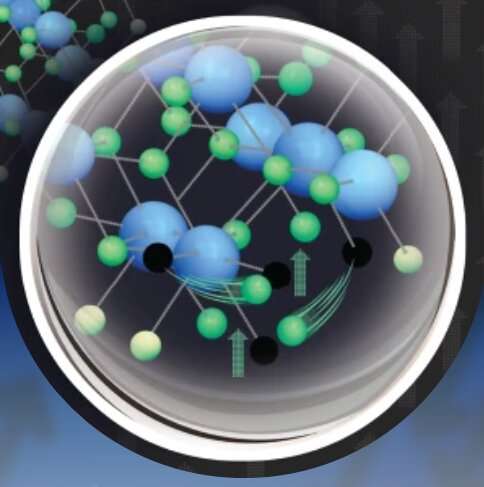This article has been reviewed according to Science X's editorial process and policies. Editors have highlighted the following attributes while ensuring the content's credibility:
fact-checked
peer-reviewed publication
trusted source
proofread
Exploring the properties of very thin hafnium dioxide

The chemistry of hafnium dioxide (known as hafina) is rather boring. Yet, the behavior of ultrathin layers that are based on this material is very interesting: they can be used as non-volatile computer memory through the switching of dipoles with an electric field.
And as the dipole strength depends on the history of the electric field, it is suitable for the construction of memristors for 'brain-like' computer architectures. Beatriz Noheda, Professor of Functional Nanomaterials at the University of Groningen, has studied the material and recently wrote a Perspective article on its properties for the journal Nature Materials. "It is already used in devices, even though we do not understand all of the physics."
To create more efficient computers, fast non-volatile random-access memory (RAM) is required. Ferroelectric materials appeared to be good candidates. These materials are made up of units with dipoles that will switch collectively using an electric field. However, their properties break down if the number of units is too small; spontaneous depolarization occurs below approximately 90 nanometers.
Oxygen vacancies
One exception is hafnia. "This was discovered more or less by accident," says Beatriz Noheda. Hafnia is very stable at high temperatures and in hostile environments and is traditionally used in the metallurgical and chemical engineering industry. It did, however, attract the attention of microchip manufacturers when amorphous hafnia turned out to be a very efficient gate insulator in transistors. Noheda: "By replacing the traditional silicon oxide with hafnia, transistors could be made smaller."
Noheda's interest in the material stems from her work for the Groningen Cognitive Systems and Materials Center (CogniGron), of which she is the scientific director. The aim of CogniGron is to create a neuromorphic computing architecture. Hafnia is one of the materials that are studied there. "In a paper published by Science in 2021, we describe how switching doesn't just occur simply through dipoles. We found that the movement of oxygen vacancies also plays a role," says Noheda.
Sustainable
Hafnia behaves like a ferroelectric, but it retains its properties only at the nanometer scale. Noheda: "Ferroelectrics appeared to be out of the race as contenders for very small non-volatile RAM, but with hafnia, they are now in the lead." That said, it appears that hafnia does not exactly behave like a ferroelectric. "We need to understand this to fully use its potential," says Noheda. "And I believe that we are getting there. As mentioned, the movement of oxygen vacancies appears to be crucial for its properties."
Noheda also points to another concept that should be taken into account: the surface energy in nanoparticles. "The phase diagram shows that the relatively large surface area of these particles creates the equivalent of an extremely high pressure in hafnium dioxide, which appears to play a role in the properties of this material."
This type of knowledge is important in the search for other materials that behave like hafnium. "Hafnium is not the most sustainable option for microchip production since the worldwide supplies are too small. By looking for materials with similar properties, we might find a better candidate." One option could be zirconium.
Neuromorphic chips
Finding a sustainable alternative for hafnium could accelerate the use of ferroelectrics in RAM memory. And since the dipole strength depends on the history of the electric field that generates the dipoles, it would be an ideal material to produce memristors, which allows intermediate values between de classic binary values of 0 and 1.
Such analog devices could behave like the neurons in our brain and would be candidates for a neuromorphic computer architecture. "We are working towards such neuromorphic chips. But first, we must fully understand the physics of hafnium dioxide and similar materials."
More information: Beatriz Noheda et al, Lessons from hafnium dioxide-based ferroelectrics, Nature Materials (2023). DOI: 10.1038/s41563-023-01507-2
Journal information: Nature Materials , Science , Nature
Provided by University of Groningen





















